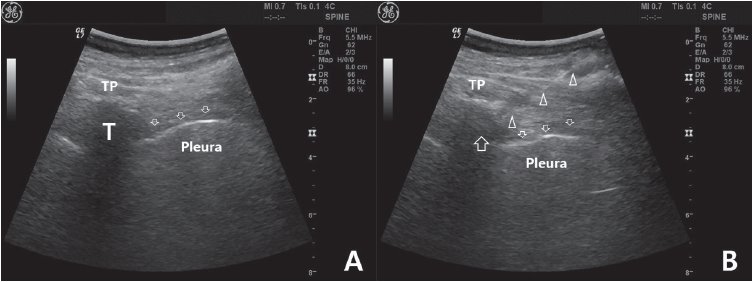Kosin Med J.
2019 Dec;34(2):152-160. 10.7180/kmj.2019.34.2.152.
Treatment of Isolated Sternal Fracture with Ultrasound-Guided Paravertebral Nerve Block: a Case Report and Literature Review
- Affiliations
-
- 1Department of Anesthesiology and Pain Medicine, School of Medicine, Kyungpook National University, Kyungpook National University Hospital, Daegu, Korea. pjm4013@naver.com
- KMID: 2467976
- DOI: http://doi.org/10.7180/kmj.2019.34.2.152
Abstract
- In the case of isolated sternal fractures, conservative treatment with analgesics is common, but pain can persist for more than 10 weeks, which can significantly interfere with daily life. Ultrasound-guided paravertebral nerve block is reported to be a successful means of pain control in patients with chest wall injury or rib fracture. A 70-year-old female patient presented with anterior chest pain that had persisted for 2 weeks despite conservative treatment. Sagittal reconstruction chest computed tomography and sternum lateral oblique x-ray revealed an isolated sternal fracture. An ultrasound-guided bilateral paravertebral nerve block was performed for pain control. After performing the procedure twice at a 1-week interval, the patient reported complete pain alleviation, and no other problems were observed over the 3-month follow-up period. Ultrasound-guided bilateral paravertebral nerve block can help patients with isolated sternal fractures to manage pain and return to normal activities sooner than with oral analgesics.
Keyword
MeSH Terms
Figure
Reference
-
1. Yeh DD, Hwabejire JO, DeMoya MA, Alam HB, King DR, Velmahos GC. Sternal fracture--an analysis of the National Trauma Data Bank. J Surg Res. 2014; 186:39–43.
Article2. Klei DS, de Jong MB, Öner FC, Leenen LPH, van Wessem KJP. Current treatment and outcomes of traumatic sternal fractures-a systematic review. Int Orthop. 2019; 43:1455–1464.
Article3. Sadaba JR, Oswal D, MunschCM . Management of isolated sternal fractures: determining the risk of blunt cardiac injury. Ann R Coll Surg Engl. 2000; 82:162–166.4. de Oliveira M, Hassan TB, Sebewufu R, Finlay D, Quinton DN. Long-term morbidity in patients suffering a sternal fracture following discharge from the A and E department. Injury. 1998; 29:609–612.
Article5. Carter GT, Duong V, Ho S, Ngo KC, Greer CL, Weeks DL. Side effects of commonly prescribed analgesic medications. Phys Med Rehabil Clin N Am. 2014; 25:457–470.
Article6. Oyetunji TA, Jackson HT, Obirieze AC, Moore D, Branche MJ, Greene WR, et al. Associated injuries in traumatic sternal fractures: a review of the National Trauma Data Bank. Am Surg. 2013; 79:702–705.
Article7. Raghunathan R, Porter K. Sternal fractures. Trauma. 2009; 11:77–92.
Article8. Perez MR, Rodriguez RM, Baumann BM, Langdorf MI, Anglin D, Bradley RN, et al. Sternal fracture in the age of pan-scan. Injury. 2015; 46:1324–1327.
Article9. Terry NL, Watts JR Jr, Sonavane SK, Beasley TM, Munden R, Nath PH, et al. Improved identification of sternal injuries with multidetector computed tomography (MDCT): sagittal reconstructions. Clin Imaging. 2016; 40:739–744.
Article10. Nickson C, Rippey J. Ultrasonography of sternal fractures. Australas J Ultrasound Med. 2011; 14:6–11.
Article11. Racine S, Émond M, Audette-Côté JS, Le Sage N, Guimont C, Moore L, et al. Delayed complications and functional outcome of isolated sternal fracture after emergency department discharge: a prospective, multicentre cohort study. CJEM. 2016; 18:349–357.
Article12. Raza I, Narayanan M, Venkataraju A, Ciocarlan A. Bilateral Subpectoral Interfascial Plane Catheters for Analgesia for Sternal Fractures: A Case Report. Reg Anesth Pain Med. 2016; 41:607–609.
Article13. Burns LT, Beasley DA, Stevens MA, Crabtree DE, Mehaffey GR. Pectointercostal Fascial Block Catheters for Thoracic Injuries: A Case Series. A A Pract. 2018; 11:340–343.
Article14. Bondár A, Szucs S, Iohom G. Thoracic paravertebral blockade. Med Ultrason. 2010; 12:223–227.
- Full Text Links
- Actions
-
Cited
- CITED
-
- Close
- Share
- Similar articles
-
- Ultrasound-guided Aspiration of the Iatrogenic Pneumothorax Caused by Paravertebral Block: A Case Report
- Ultrasound-guided Femorosciatic Nerve Block by Orthopaedist for Ankle Fracture Operation
- Bilateral variant locations of the musculocutaneous nerve during ultrasound-guided bilateral axillary brachial plexus block: A case report
- The Efficacy of Ultrasound-Guided Lower Extremity Nerve Block in Trauma Patients
- Ultrasound-Guided Intervention in Lumbar Spine




